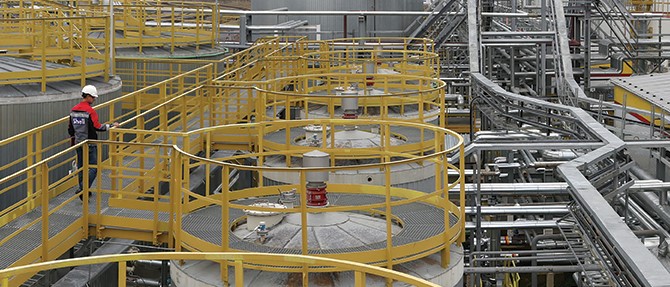MOSCOW – Eastern Europes lubricant demand stalled during the past few years due to adverse economic conditions, according to an industry insider.
In 2015, Eastern Europe accounted for 45 percent of Europes 6.7 million tons of finished lubricants demand, said Christian Ohligmacher, vice president for Central and Eastern Europe for Mannheim, Germany-based lube maker Fuchs. Western Europe accounted for the remaining 55 percent. In 2007, Europes total lubricants demand reached 8.4 million, with Eastern Europe accounting for 43 percent and Western Europe 57 percent.
The region includes the Balkans and some central European countries such as Hungary and Slovakia, along with Poland, Ukraine and Russia.
The three biggest East European markets, Poland, Russia and Ukraine, combined held 27 percent of the total European lubricant market. The unfavorable economic situation in the region has decreased the lubricant demand by 3.3 percent in 2015, compared to the year before, Ohligmacher told RPIs Lubricants Russia conference held here in November. In 2015, Eastern Europe consumed almost 3 million tons of finished lubricants, while Western Europe consumed 3.7 million tons.
Fuchs also found that in 2015, Eastern Europe consumed 7 kilograms of lubricants per capita, while Western Europeans consumed 9 kg.
Russia is the largest economy in the region, and since 2009 its gross domestic product has seen a steady growth, followed by growth in industry sectors such as steel, chemical and car production – all of them have driven lubricant demand, Ohlighmacher said.
However, 2014 brought troubles in the Russian economy. Russia annexed Crimea on the Ukrainian peninsula and logistically backed an armed insurgency in Eastern Ukraine. This led Western countries to impose sanctions on Russia, and as a result, combined with low oil prices, the Russian economy entered a recession for two consecutive years. Lubricant demand also plunged.
Ukraines lubricant demand has seen a steady decline since 2007, with a small uptick in 2009. But generally, the countrys disastrous industrial performance has driven the economy down since 2010, Fuchs found. In the last five years, Ukrainian steel and chemical production dropped significantly, affecting the lubricant demand too, Ohligmacher said, adding that the countrys passenger car production stalled to virtually zero in 2015.
Following the global economic recession in 2009, Polands lubricant demand has shown steady growth since 2010, driven by strong steel and chemical production. Since the recession years the countrys gross domestic product has been excellent, and the car production rebounded in 2013 after a five-year drop, Ohligmacher said.
Fuchs found that the lubricants industry in Eastern Europe is challenged by stagnating lubricant demand and shifts in regional demand. Also as a challenge we have the changing requirements related to sustainability, efficiency and regulatory standards, as well as technological changes such as raw material landscape, electro mobility and 3D printing, Ohligmacher said.
He added that dirty energy sources, such as coal and oil, are set to decline, while many industrialized countries in Europe will impose a renewable energy regime. This could potentially impact lubricant manufacturers, he said, including a change in customer structure in the energy sector, different products required for electric motors, and production of new materials enabled by lower energy costs.

Photo: Shell